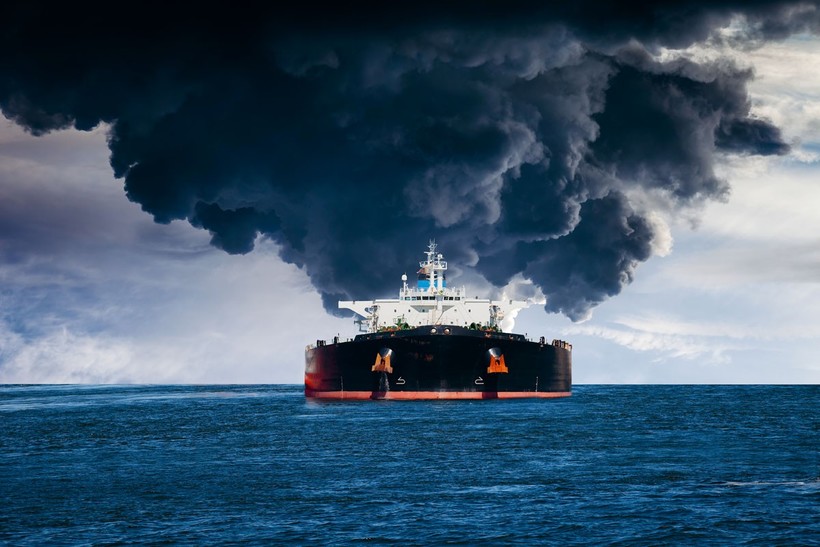The Zero-Carbon Shipping
The increased environmental standards for operating in the Arctic region impose strict requirements on the quality of marine fuel. This is a serious challenge for Russia and shipowners, who will have to find a cleaner alternative, learn to use it and complete the transition, thinks Nikita Dobroslavsky.

Shipping in the Arctic is an important
element of socio-economic development and, in
most cases, is the only way to import materials and
component parts and export
nished industrial
products. As a result, industrial projects in the
Arctic have a potentially high impact on the
environment, not only directly at the project site
but also along the entire Arctic shipping route.
e International Maritime Organization
(IMO) sets emission standards for acidic oxides
(NOx, SOx) in shipping. In addition, there is an
ongoing debate about regulating CO2 emissions,
as well as so-called black carbon emissions, which
are formed by incomplete combustion of fossil
fuels, wood and other fuels. ese requirements
apply in all regions of the world.
For the Arctic
region, however, the risks of fuel spills are to be
considered with utmost attention since their cleanup is obstructed by the harsh climatic conditions
and the low density of spill-response facilities.
For a long time, the regulatory mechanisms for
shipping concerned only the quality of fuel and its
sulphur content. At the same time, international
and national emission control areas were identi
ed,
where more stringent requirements applied to fuels
and emissions of acidic oxides.
For the Antarctic zone, a straightforward ban was
introduced on use of residual fuels. It is expected
that, from 2024, it will be introduced in the Arctic
too, but it may be postponed until 2029 for certain
types of ship. Recently, the impact of black carbon
on the climate and global warming processes has
been actively discussed.
e most stringent requirements are set for
emission control areas (ECAs). But there are no
plans to establish an ECA in the Arctic seas. Instead,
environmental safety will be ensured by controlling
the types of fuel used by marine vessels. A ban on
using residual fuels, including fuel oil and various
heavy fuels (HFO), in shipping in this region is
considered a priority.
At the same time, there are no plans to ban
transportation of oil and fuel oil in the Arctic
since petroleum products provide for the supply of
essential goods and serve as the basis for the energy
supply to local Arctic communities.
Based on this, the ban on use of HFO will have
a major impact not only on shipping and energy
supply to consumers, but also on mining projects in
the Russian Arctic. is is because, when exporting
products, cargo ships cross the Arctic waters zone
and, in the event of such a ban, they would need to
transfer fully to using other types of fuel.
e ban on use of HFO will certainly raise
costs for maritime transport, which will reduce
the people’s disposable income and increase costs
for industrial enterprises. Yet, the ban could have
a signi
cant positive impact on the state of the
environment, the quality and life expectanc of the local population, and preservation of the
traditional way of life of the indigenous population. At the same time, the environmental consequences
of using alternative fuels are not fully understood,
which creates greater uncertainty and risks when
switching to alternative fuels.
Such a ban will also apply to fuel oil with a low
sulphur content – this is a residual fuel that is not
an environmentally friendly alternative to HFO.
In this respect, the following scenarios may be
identi
ed for the Russian Arctic
eet in the context
of the increasing environmental requirements.
Shipowners and
eet operators in the Russian
Arctic are facing a rather di
cult strategic choice.
Use of low-sulphur residual and distillate fuels will
immediately raise operating costs. At the same time,
installation of a scrubber – a special device used for
removing various compounds from gases – will not
allow for use of fuel oil aer use of residual fuels in
the Arctic is banned in 2024.
Even greater risks are faced by shipowners when
building new vessels that require high capital
investments. At the same time, converting to LNG
or ordering a new
eet is the most capital-intensive
investment solution. In this case, however, the
eet will be allowed to operate in the Arctic zone
for the long term, until 2050. Even the strict new
environmental requirements will not aect the operational activities and will not lead to additional
capital costs during the ship’s life cycle.

IN SEARCH OF AN ALTERNATIVE
Since maritime transport is the most cost-eective
means for delivering goods – today, more than 80%
of world trade goods travel by sea – signi
cant
results in reducing global greenhouse gas emissions
can be achieved by regulating the quality of fuel
used in shipping. is can also be done by further
tightening the emission standards for fuel use.
In particular, the IMO is expected to introduce
additional emission restrictions and requirements
on the quality of fuel for shipping by 2050.
Reduced emissions along the production chain
can be achieved in many ways. In particular, this
can be done by reducing fuel consumption and
improving the energy e
ciency of marine engines
through technological improvements, use of fuels
with a reduced carbon footprint (for example,
LNG), as well as capture and neutralisation of
emissions. Scrubbers and neutralisers can be used for
this purpose.
Conversion to fuels with a lower carbon footprint
in their production and use is a key area for reducing
greenhouse gas emissions from shipping.
e following types of fuel are considered as
alternative fuels suitable for shipping in the long term gas – LNG, hydrogen, methanol, and ammonia.
These fuels can also be produced in limited
quantities using renewable raw materials or
electrochemical technology. Two types of fuel,
LNG and methanol, are, however, currently
considered the most promising for use in the
Arctic for various reasons.
LIQUEFIED NATURAL GAS
Of all the possible types of alternative fuel,
there is more practical experience of using
LNG in shipping. This is due to the big LNG
production volumes in the world (more than
350 m tonnes a year), the high maturity of LNG
storage and use of technologies on board ship, as
well as the wide availability of LNG in various
parts of the world.
Most estimates of LNG use as a fuel show a
significant reduction in CO2 emissions into
the atmosphere. This reduction is achieved by
reducing both the relative carbon content of the
fuel and its specific consumption.
Even so, LNG as a fuel has a number of
ddisadvantages associated with so-called
methane slips, the unburned methane residues
in the engine exhaust gases. Methane slip
contributes to the most to the carbon footprint
when LNG is used as methane has a high
greenhouse potential. At the same time, progress
in the engine industry allows methane slip to
be reduced many times over. In fact, we can say
that, in the near future, the issue of methane
slip when using LNG will become significantly
less acute.
When assessing the contribution made by
LNG to the climate situation, it is necessary to
take into account the area of origin and area of
use of the LNG. The Russian Arctic is becoming
a global LNG production hub because of the
modern technologies in place and improved
energy efficiency of production due to use
of external cold.
The possibility of directly
shipping LNG for bunkering without the need
for long-distance transportation results in a
reduced carbon footprint and lower greenhouse
gas emissions. In particular, the carbon footprint
of LNG production at the Yamal LNG plant
is significantly lower than that of most LNG
plants in the world. This could play a key role in
developing Arctic shipping.
METHANOL
Methanol could be a second promising transport is
well developed and has been widely used for many
years. In particular, there are many examples of
mass use of methanol as an additive to petroleum
fuels in the United States, China and the Middle
East. Use of methanol on ships is signi
cantly less
widespread.
Th e prospects for the use of methanol are based on:
• need to diversify fuels for shipping
• suficcient ease of storage on board the vessel
• possibility of producing methanol from
biological raw materials or using electrochemical
technologies with capturing CO2 from
atmospheric air
• wide geography and large volume (more than
80 million tons a year) of methanol production
worldwide
• possibility of using both internal combustion
engines and fuel cells
In addition, methanol is easily decomposed by
living microorganisms, which greatly facilitates the
elimination of its spills. At the same time, unlike
LNG spills, methanol spills do not result in GHG
production.
Methanol has a high octane number, which
allows it to be used e
ciently in spark-ignition
engines. It is also characterised by a low cetane
number, which prevents it from being used directly
in compression-ignition engines. At the same time,
it does not contain sulphur and the lower speci
c
calori
c value of methanol results in more fuel
being required.
Today, several projects are under way in the
world to convert ships to methanol. In particular,
the Green Maritime Methanol, Pon Power, and
FASTWATER consortia are engaged in this work.
Russia also has experience in using this type of fuel.
In the autumn of 2020, the
rst Flotmetanol pilot
project of a
oating methanol plant was launched
o the coast of Yamal. e plan is for its capacity to
reach 10 thousand tonnes a year.
In turn, methanol is used by Russian oil and gas
companies in hydrocarbon production projects.
Raw materials come from the Tazovsky oil and
gas condensate
eld, which is being developed
by Gazprom Ne. In the future, it is planned
to develop the bunkering of ships, creating the
infrastructure needed to service ships of the new
type with engines running on methanol.

Nikita Dobroslavsky is expert at
the SKOLKOVO Moscow School
of Managemen










